|
Dr Nebogipfel,
I presume?

A wonderful, thorough, 'must-have'
annotated edition of The Time Machine
"Apart from its outstanding literary repute, The Time Machine is
remarkable for its 'complex bibliographical history,
which must be unparalleled among works of modern fiction' (Begonzi 1960:42; see also Lake
1980). Begun in 1888 as an amateur effort, it went through six drafts, three of them
published (see appendices I-III) before it appeared in two different versions in New York
and London (1895b and 1895c), and even then Wells did not stop tinkering with it until one
last refinement done for The Scientific Romances of H.G. Wells (1933a).
From the Introduction to Leon Stover's The
Time Machine : An Invention : A Critical Text of the 1895
London First Edition, With an Introduction and Appendices
(Annotated H.G. Wells, 1)
Considering the fact that you can buy a paperback for a few dollars... or
even read the complete text right here on
the site... is it worth shelling out $49.95 for this edition? Well,
if you already know what an 'amateur cadger' is, or what it means when
they 'plow you for the little-go,' then I guess you could skip it. But
if these and other Wells references, phrases, and allusions are lost
on you, getting Stover's book is a treat.
It would be worth $149.95. Or even $249.95. At $49.95, it's a downright steal. Buy it!
If you travel to the future... make this one of the three books you take. (By the way,
clicking on any of the book titles on this page will take you to its Amazon.com listing)
Stover's omnibus contains many of the variations, focusing on the text of the
1895 London First Edition. Annotations explain all the textual references, which
adds immeasurably to the reader's enjoyment. The notes are easily accessed - with footnote
numbers appearing in the text and the corresponding annotation appearing at the bottom of
the very same page. (Indeed, the annotations probably contain as many words as the text
itself!) While Wells' prose is every bit as entrancing and engrossing as it was over a
hundred years ago, certain topical references and obscure allusions which might otherwise
be lost are made clear through Stover's incisive (and exhaustive) annotation. This edition
also includes alternate versions of The Time Machine by Wells, notably "The
Chronic Argonauts," the earliest version of the story: dark, haunting, and radically
different from the versions to come. In "The Chronic Argonauts," which first
appeared in The Science Schools Journal in 1888, you lean that the unnamed Time
Traveler of the classic text was originally named Dr. Moses Nebogipfel.
The book also contains Wells' second revision, "The Time Traveler's
Story," which appeared in The National Observer in 1894.
Also included are excerpts from the Heinemann edition of The Time Machine, which was
taken from a serialized version published during the first half of 1895. Was Wells correct
in excising the "ghastly rabbits and centipedes" as the descendants of the Eloi
and Morlocks? You can read it for yourself and decide.

I am a Chronic Argonaut, an explorer of epochs, a man for all
time, a Morlock fighter...
Another Annotated edition with interesting bonuses
Childhood fears also left their mark on The Time Machine. At the age of seven,
Wells, poring over a copy of John George Wood's The Boy's Own Book of Natural History,
"...conceived a profound fear of the gorilla, of which there was a fearsome picture.
[I imagined that it came] out of the dark and followed me noiselessly about the
house. The half landing was a favorite lurking place for this terror. I passed it
whistling, but wary and then ran for my life up the next flight."
From the Introduction to Harry M. Geduld's The
Definitive Time Machine : A Critical Edition of H.G. Wells's Scientific
Romance
This text for this definitive text comes from the 1924 Atlantic edition of Wells's
"The Time Machine." The annotations here are far less conveniently located than
in the Stover edition. They're grouped together at the conclusion of the text, and there
are no footnote numbers - just chapter and page references, so the reader has to do a bit
of searching to find the text being commented upon.
Includes four pages of material "which does not appear in any previously published
edition of The Time Machine" - an alternate ending in which the Time Traveler (named
"Bayliss" in these fragments!) "...loses his Time Machine after being
ejected from it." A longer fragment describes the return of the Time Traveler, his
sojourn in 2,000,000 B.C. and his arrival on New Year's Day of 1645, where the locals
shoot at him... before he returns to his own time. The short fragments come from the
H. G.
Wells Collection of the University of Illinois Library at Urbana-Champaign.
Also appearing in this volume are "How To Construct A Time Machine," by
Alfred Jarry... and an intriguing excerpt from Terry Ramsaye's history of the early
cinema, "A Million and One Nights," concerning Robert W. Paul.
Paul patented a 'virtual reality' theme-park-style ride -- in 1895. Based on the idea
of presenting time travel using brand-new motion picture technology, the invention,
according to Paul, "...consists of a platform, or platforms, each of which contains a
suitable number of spectators and which may be enclosed at the sides after the spectators
have taken their places... In order to create the impression of traveling, each platform
may be suspended from cranks in shafts above the platform... placed so as to impart to the
platform a gentle rocking motion, and may also be employed to cause the platform to travel
bodily forward through a short space. The films or slides are prepared with the aid of the
kinetograph or special camera, from made up characters performing on a stage..."
Not bad, considering that the narrative movie was still nearly two decades away, and
the platform-based thrill-park ride wouldn't show up for nearly another hundred
years!

Suddenly, out of the
blue, The 1895 Holt Time Machine materialized in 1969...
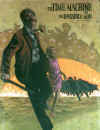
Children's edition (mistakenly?) uses text of disavowed New York first printing
 | The Time Machine and The Invisible Man. Annotated;
Complete and unabridged. Illustrated by Dick Cole, Cover by Don Irwin. Classic Press
Incorporated/ Children's Press, 1969. LOC 70-79993 |
The first time I saw this large, school-bookish-looking edition of "The Time
Machine," I was puzzled.
The opening paragraph was completely different from the book I knew. My initial thought
was that I was reading an adaptation especially created for school children. But why,
then, did the title page state "complete and unabridged?" Further, if this was
an adaptation, why offer definitions of obscure words (sometimes supplemented by pictures)
in the extra-wide margins? Why not simply re-phrase?
The answer: this edition reprints an early version of the story -- one that Wells later
disavowed. This collectable curiosity makes for fascinating reading, reprinting as it does
the text of the U.S. Holt edition.
Geduld on this version of the story:
The British edition of The Time Machine published by Heinemann in 1895 is
often referred to as the first edition.
In fact, it was not issued until 29 May 1895, whereas the American edition,
published by Henry Holt and Co., was published on 7 May or earlier. The
Holt version differs in a number of important respects and in numerous
stylistic details from both the New Review Text [a serialized version
which appeared in the New Review from January through May of 1895].
For example, Chapter 1 of the Holt text looks like a curious blend of
passages from both the National Observer and the New Review
versions -- although [Wells Scholar] Philmus believes that the Holt text
probably antedates the New Review Version -- and the New Review
and Heinemann versions conclude with the memorable, poetic epilogue, while
the Holt version ends rather blandly with a terse account of what had
become of the Time Traveler's guests during the period of his disappearance.
On the basis of textual collation, [Wells Scholar] Bergonzi concludes:
'There is a very strong probability that' the Holt version is 'an early
and unrevised version' of the New Review and Heinemann texts. 'Wells
may have virtually disowned the New York edition since it represented
an unrevised text, and this may account for his subsequent silence about
it.'"
I strongly suspect that the publishers of the 1969 edition were either unaware of their use
of a variant text, or were perhaps in some way the business successors to Holt.
(Imagine the problems that may have been created when a student scholar, using this
volume, makes references to passages and events which do not appear in the text belonging
to that student's teacher, who's using a paperback edition for convenience!)
I searched and searched for a copy of this, before I even realized what it was. I
had only seen a copy in the Children's Section of a local library... and was intrigued by
the curious content, marginal notations, and odd pen and ink illustrations. I
finally found and purchased a fine copy on eBay for about $6... quite a bargain, I think,
now that I appreciate what I got.
Worth seeking out, but rare -- use "Cole" as a keyword in your searches (the
illustrator) to locate this edition.
 | The FIRST version of The Time Machine was titled "The Chronic Argonauts" and
appeared in Science Schools Journal, the students' magazine of the Royal College of
Science, serialized over April, May, and June of 1888. |
 | The SECOND and THIRD versions were produced by Wells between 1889-1892. These versions
are lost. |
 | The FOURTH Version is the National Observer Version (substantially shorter than the
Atlantic version, the text most commonly reprinted today) and appeared in that publication
between March through June 1894, though it was never finished. In this version, The Time
Traveler visits 12,203 rather than 802,701. |
 | The FIFTH version is the New Review text, "closer," according to Geduld,
"to the final book version than it is to the National Observer serialization"
Published in New Review between January through May of 1895. |
 | The SIXTH version is the Holt edition, the one reprinted in the volume currently under
discussion. |
 | The SEVENTH version is the Heinemann edition of 1895, the first British publication of
The Time Machine in book form. |
 | The EIGHTH version first appeared as the first volume in the Atlantic Edition of The
Works of H.G. Wells, and is today considered the standard text. According to Geduld, the
"divergencies from the Heinemann edition are all quite minor. Geduld's Definitive
Time Machine reprints the Atlantic text; Stover reprints the 1895 Heinemann edition...
|

Opening Paragraph, HOLT EDITION: The
man who made the Time Machine - the man I shall call The Time Traveler
- was well known in scientific circles a few years since, and the fact
of his disappearance is also well known. He was a mathematician of peculiar
subtlety, and one of our most conspicuous investigators in Molecular physics.
He did not confine himself to abstract science. Several ingenious, and
one or two profitable, patents were his: very profitable they were, these
last, as his handsome house at Richmond testified. To those who were his
intimates, however, his scientific investigations were nothing to his
gift of Speech. In the after dinner hours he was ever a vivid and variegated
talker, and at times his fantastic, often paradoxical, conceptions came
so thick and close as to form one continuous discourse. At these times
he was as unlike the popular conception of a scientific investigator as
a man could be. His cheeks would flush, his eyes grow bright; and the
stranger the ideas that sprang and crowded in his brain, the happier and
more animated would be his exposition.
Opening Paragraph, ATLANTIC EDITION: The
Time Traveler (for so it will be convenient to speak of him) was expounding
a recondite matter to us. His grey eyes shone and twinkled, and his usually
pale face was flushed and animated. The fire burned brightly, and the
soft radiance of the incandescent lights in the lilies of silver caught
the bubbles that flashed and passed in our glasses. Our chairs, being
his patents, embraced and caressed us rather than submitted to be sat
upon, and there was that luxurious after-dinner atmosphere when thought
roams gracefully free of the trammels of precision. And he put it to us
in this way--marking the points with a lean forefinger--as we sat and
lazily admired his earnestness over this new paradox (as we thought it:)
and his fecundity.
Closing Paragraph, HOLT EDITION: But I am
beginning to fear now that I must wait a lifetime for that. The Time Traveler
vanished three years ago. Up to the present he has not returned, and when
he does return he will find his home in the hands of strangers and his
little gathering of auditors broken up forever. Filby has exchanged poetry
for playwriting, and is a rich man -- as literary men go -- and extremely
unpopular. The Medical man is dead, the Journalist is in India, and the
Psychologist has succumbed to paralysis. Some of the other men I used
to meet there have dropped as completely out of existence as if they,
too, had traveled off upon some similar anachronisms. And so, ending in
a kind of dead wall, the story of the Time Machine must remain for the
present at least.
Closing Paragraph, ATLANTIC EDITION: One
cannot choose but wonder. Will he ever return? It may be that he swept
back into the past, and fell among the blood-drinking, hairy savages of
the Age of Unpolished Stone; into the abysses of the Cretaceous Sea; or
among the grotesque saurians, the huge reptilian brutes of the Jurassic
times. He may even now--if I may use the phrase--be wandering on some
plesiosaurus-haunted Oolitic coral reef, or beside the lonely saline lakes
of the Triassic Age. Or did he go forward, into one of the nearer ages,
in which men are still men, but with the riddles of our own time answered
and its wearisome problems solved? Into the manhood of the race: for I,
for my own part cannot think that these latter days of weak experiment,
fragmentary theory, and mutual discord are indeed man's culminating time!
I say, for my own part. He, I know--for the question had been discussed
among us long before the Time Machine was made--thought but cheerlessly
of the Advancement of Mankind, and saw in the growing pile of civilization
only a foolish heaping that must inevitably fall back upon and destroy
its makers in the end. If that is so, it remains for us to live as though
it were not so. But to me the future is still black and blank--is a vast
ignorance, lit at a few casual places by the memory of his story. And
I have by me, for my comfort, two strange white flowers --shrivelled now,
and brown and flat and brittle--to witness that even when mind and strength
had gone, gratitude and a mutual tenderness still lived on in the heart
of man.

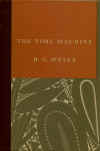 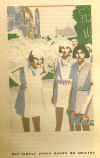 Page under construction - reviews of these editions to come. This is the
Random House "Art Deco" version, with Eloi that look like Joan
Crawford. It's slipcased and surprisingly easy to find.
Page under construction - reviews of these editions to come. This is the
Random House "Art Deco" version, with Eloi that look like Joan
Crawford. It's slipcased and surprisingly easy to find.
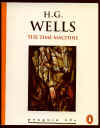 This is a Dover Thrift Edition... under a buck.
This is a Dover Thrift Edition... under a buck.
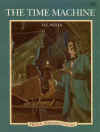 This
is a really nicely illustrated children's abridgement, currently available. This
is a really nicely illustrated children's abridgement, currently available.
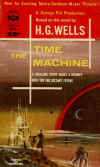  The Movie Tie-in paperback.
The Movie Tie-in paperback.

Two Books...
Which would you choose?
 This in-print Dover
Edition sells for 80 cents, brand new, at Amazon.com.
This in-print Dover
Edition sells for 80 cents, brand new, at Amazon.com.
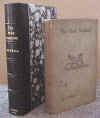 An out-of-print first edition (similar to this one) is on the market for
$25,000.00.
An out-of-print first edition (similar to this one) is on the market for
$25,000.00.

ARMED SERVICES EDITIONS were cheaply
produced and distributed free in the expectation that they would not only
be read, but read up, as well. As it happened, some GI's brought copies
home when they came back from the war; and even today, odd ASE volumes
are easily and cheaply acquired in second-hand bookshops (the going rate
for run-of-the-mill copies is about $2).
Typical
British first editions of The Time Machine sell from $750 to $2500. If
you'd prefer to spend more money than that for a copy that is distinguished
primarily by the misspelling of "H.G. Wells," contact James
Pepper Rare Books, Inc., 2026 Cliff Drive, Suite 224, Santa Barbara, CA
93109 USA, which offers this incredibly rare presentation copy for $32,000.00.
WELLS, H.G: The Time Machine. An
Invention ; 4181J London William Heinemann 1895 First English
Edition. This is the only known copy in cloth with the author�s name misspelled
�H.S. Wells� on the front cover. The Time Machine was issued a few weeks
earlier in America by Henry Holt and curiously the earliest Holt copies
were misspelled �H.S. Wells� on the title page. As this is Wells� first
book and he was then a virtual unknown, it is easy to see how such a mistake
occurred. Well�s name is spelled correctly on the title page of all known
English copies but amazingly this single copy exists stamped with the
error on the binding. The English first edition has always been a complicated
affair which noted science fiction bibliographer L.W. Currey has attempted
to reveal and he has recorded six different types of copies in wrappers
and cloth. This copy conforms to none of Currey�s copies. This copy is
bound in a light tan cloth as opposed to the usual gray cloth; measures
18.2 centimeters vertically; the top edges rough trimmed and the fore-edges
untrimmed and does not have a publisher�s catalogue. The front cover is
stamped with the winged Egyptian lion with the Pharoah�s face as present
in the regular English copies though the stamping is a warmer shade of
purple than the usual dark purple stamping. The �T� in the first word
of the title in the spine is a different type face from the rest and the
title stamping on the front cover is two tenths of a centimeter small
than normal copies. The possibility exists that this is a single trial
copy. Spine darkened, and some very minor stains to rear cover, otherwise
very good to fine. Obviously, this is the earliest existing copy of the
first English edition in cloth. Wells� finest work and along with Frankenstein,
the most influential piece of 19th century science fiction. Enclosed in
a custom slipcase.
Don
Brockway, March 1, 2000 (updated October 12, 2004)
[ Early
Editions ] [ The
Book ] [ The
Time Machine Home Page ]
|
